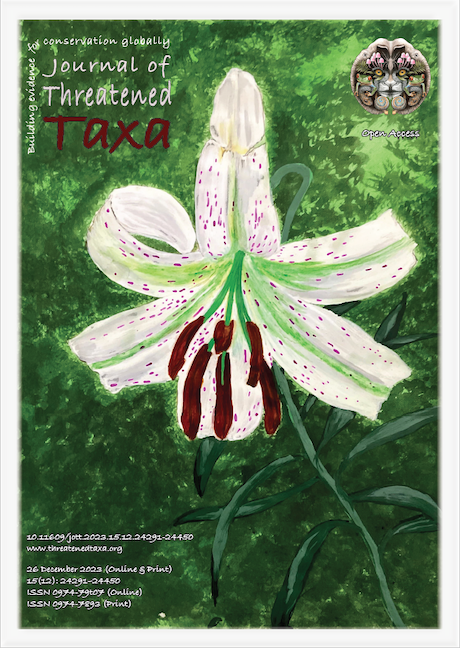Report of new myristica swamp ecosystems from the Western Ghats at Pathanapuram, Kerala, India
Main Article Content
Abstract
We present a new distributional report of myristica swamp ecosystems in the Western Ghats at Pathanapuram, Kerala, India based on several distinct field surveys from April 2022 to June 2022. From Kerala, myristica swamp has previously been reported mainly from Shendurney Wildlife Sanctuary, Kulathupuzha Reserve Forests, and adjoining regions of the Anchal forest ranges in southern Western Ghats. The present study described and illustrated the occurrence of myristica swamp from the Pathanapuram forest range in Kerala for the first time. The observed myristica swamps from the Pathanapuram forest range are seen inside the Ambanar model forest station and Punnala forest station limits. A total of 18 myristica swamp patches from Ambanar and seven myristica swamps from Punnala were reported and captured. A pilot survey from these sites suggests they are abundant with various faunal and floral wealth. Therefore, recognition and conservation of these ecosystems are essential and vital and suggest further surveys and conservation efforts.
Article Details

This work is licensed under a Creative Commons Attribution 4.0 International License.
Authors own the copyright to the articles published in JoTT. This is indicated explicitly in each publication. The authors grant permission to the publisher Wildlife Information Liaison Development (WILD) Society to publish the article in the Journal of Threatened Taxa. The authors recognize WILD as the original publisher, and to sell hard copies of the Journal and article to any buyer. JoTT is registered under the Creative Commons Attribution 4.0 International License (CC BY), which allows authors to retain copyright ownership. Under this license the authors allow anyone to download, cite, use the data, modify, reprint, copy and distribute provided the authors and source of publication are credited through appropriate citations (e.g., Son et al. (2016). Bats (Mammalia: Chiroptera) of the southeastern Truong Son Mountains, Quang Ngai Province, Vietnam. Journal of Threatened Taxa 8(7): 8953–8969. https://doi.org/10.11609/jott.2785.8.7.8953-8969). Users of the data do not require specific permission from the authors or the publisher.
References
Abraham, R.K., J.K. Mathew, D.V. Raju, R. Rao & A. Zachariah (2018). Reproduction and metamorphosis in the Myristica Swamp Tree Frog, Mercurana myristicapalustris (Anura: Rhacophoridae). PeerJ 6: e5934. https://doi.org/10.7717/peerj.5934 DOI: https://doi.org/10.7717/peerj.5934
Bhat, P.R. & K.M. Kaveriappa (2009). Ecological studies on Myristica swamp forests of Uttara Kannada, Karnataka, India. Tropical Ecology 50(2): 329–337.
Champion, S.H. & S.K. Seth (1968). A revised survey of the forest types of India, Government of India Press, New Delhi, 404 pp.
Chandran, M.D.S. & D.K. Mesta (2001). On the conservation of the Myristica swamps of the Western Ghats, pp. 1–19. In: Umashaanker, R., K.N. Ganeshaiah & K.S. Bawa (eds.). Forest Genetic Resources: Status, Threats, and Conservation Strategies. Oxford & IBH, New Delhi.
Chandran, M.D.S., D.K. Mesta & M.B. Naik (1999). Myristica swamps of Uttara Kannada district. My Forest 35(3): 217–222.
Gamble, J.S & C.E.C. Fischer (1936). Flora of the Presidency of Madras. Vol. 1-3. West, Newman and Adlard, London, 477–480 pp.
Ganesan, R. (2002). Evergreen forest swamps and their plant species diversity in Kalakad-Mundanthurai tiger reserve, South Western Ghats, India. Indian forester 128(12): 1351–1359.
Jose, J., T.J. Roby, K.K. Ramachandran & P.V. Nair (2014b). Species abundance distributions of selected communities in the Myristica swamp forests of southern Kerala. Current Science 107(3): 447–453.
Moorthy, K.K. (1960). myristica swamps in the evergreen forests of Travancore. Indian Forester 86(5): 314–315.
Nair, P.V., K.K. Ramachandran, K. Swarupanandan & T.P. Thomas (2007). Mapping biodiversity of the myristica swamps in southern Kerala. Kerala Forest Research Institute, Peechi, Kerala, 255 pp.
Ranganathan, P., G. Ravikanth & N.A. Aravind (2022). A review of research and conservation of myristica swamps, a threatened freshwater swamp of the Western Ghats, India. Wetlands Ecology and Management 30(1): 171–189. https://doi.org/10.1007/s11273-021-09825-5 DOI: https://doi.org/10.1007/s11273-021-09825-5
Roby, T.J. (2011). Floristic structure and diversity of Myristica Swamps at Kulathupuzha in a GIS perspective. Ph.D. thesis, FRIU, Dehradun, 148 + xxxi pp.
Rodgers, W.A. & H.S. Panwar (1988). Planning Wildlife Protected Area Network in India. Wildlife Institute of India .
Santhakumaran, L.N., A. Singh & V.T. Thomas (1995). Description of a sacred grove in Goa (India), with notes on the unusual aerial roots produced by its vegetation. Wood (Oct–Dec): 24–28.
Sasidharan, N. (2006a). Flowering plants of Kerala. A Checklist. Kerala Forest Research Institute. CD, (6).
Sasidharan, N. (2006b). TreeID. Tree identification key for Kerala”. a search engine for taxonomical purposes developed at Kerala Forest Research Institute, Peechi.Senthilkumar, N., S. Prakash, C.R. Kannan, A.A. Prasath & N. Krishnakumar (2014). Revisiting forest types of India (Champion and Seth, 1968): A case study on Myristica swamp forest in Kerala. International Journal of Advanced Research 2(2): 492– 501.
Sinu, P.A. & M.V. Sharma (2013). Insect functional guilds in the flowering canopy of Myristica fatua in a lowland swamp, central Western Ghats, India. Tropical Conservation Science 6(5): 653–662. https://doi.org/10.1177/194008291300600505 DOI: https://doi.org/10.1177/194008291300600505
Sreedharan, G. & M. Indulkar (2018). New distributional record of the northernmost Myristica swamp from the Western Ghats of Maharashtra. Current Science 115(8): 434–1436.
Sujitha, P. C., G. Prasad & K. Sadasivan (2019). Butterflies of the Myristica swamp forests of Shendurney Wildlife Sanctuary in the southern Western Ghats, Kerala, India. Journal of Threatened Taxa 11(3): 13320–13333. https://doi.org/10.11609/jott.4399.11.3.13320-13333 DOI: https://doi.org/10.11609/jott.4399.11.3.13320-13333
Varghese A.V. & B.M. Kumar (1997). Ecological observations in the fresh water swamp forests of Southern Kerala, India. Journal of Tropical Forest Science 9(3): 299–314.
Varghese, A.O. & A.R. Menon (1999). Floristic composition, dynamics, and diversity of Myristica swamp forests of Southern Western Ghats, Kerala. Indian Forester 125: 775–783.
Vasudeva, R., H.B. Raghu, U.S.R. Dasappa & K.N. Ganeshaiah (2001). Population structure, reproductive biology, and conservation of Semecarpus kathalekanensis: a critically endangered fresh water swamp tree species of the Western Ghats. Forest genetic resources: status, threats, and conservation strategies. 211–223.

